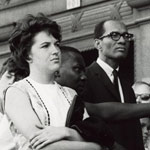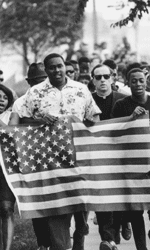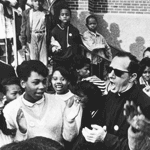| Black students Geoff McCreary, Milton Mitchell, Ross Grant, Elliot Ross, Robert Hayes, Juanita Moore and Sandy McCreary discuss their parents' migration to the North and share memories of their childhood experiences. 732k mp3 | |
| Students Juanita Moore, Henry Brown, Sandy McCreary, Elliot Ross, and Noreen Debnam discuss their experience in Milwaukee. 3.9MB mp3 | |
| African American student Gladys Coleman relates childhood lessons.140k mp3 | |
| Juanita Moore discusses her participation in a Freedom School and her disappointment with high school counseling. - 2.1MB mp3 |
Please click a thumbnail for more detail.

By adopting methods of direct-action mass protest, MUSIC chairman Lloyd Barbee (right) initiated thousands of black and white Milwaukeeans into the modern civil rights movement.
Photo courtesy of Wisconsin Historical Society.
In the mid 1960s, African American boys and girls joined their parents and activists within their community to put an end to racial discrimination in Milwaukee, the large industrial city located 80 miles to the southeast of Oshkosh. Until that time, blacks living in Milwaukee faced police brutality, crowded, substandard housing and a public school system that deliberately separated black students from white. In 1963 African American children and young adults joined the protest movement that thirty-eight-year-old attorney Lloyd Barbee and black parents had organized against the Milwaukee public schools.
Barbee and his fellow protestors wanted to draw attention to the devices that the white administrators of the Milwaukee school system had created in order to handle the influx of black students—devices such as “intact busing,” whereby entire classrooms of black children were transported to less crowded white schools for segregated classroom instruction (the black children often were not even allowed to play with white children during recess), and then subsequently driven back to their home schools for lunch, returned to the white neighborhood schools in the afternoon, and finally deposited back in their black neighborhood schools at the end of the day.
Please click a thumbnail for more detail.

Father James Groppi and his comrades took up the cause of open housing in the summer of 1967.
Photo courtesy of Wisconsin Historical Society. ID#25167
In 1964 Barbee was elected president of a coalition of civil rights, religious, and labor organizations—the Milwaukee United School Integration Committee or MUSIC—dedicated to eliminating citywide educational policies that privileged white children at the expense of blacks. Over the next two years, Barbee and MUSIC activists (most of them women) organized school boycotts, ran Freedom Schools and formed human chains around school buses in order to prevent intact busing.
By 1967, many MUSIC activists had entered the second front of the civil rights battle in Milwaukee—the fight for fair or open housing. The Milwaukee City Council had voted down a fair housing ordinance four times since black alderwoman Vel Phillips—the only African American serving the Council—first proposed one in 1962. The focal point for the open housing campaign was the St. Boniface parish headed by the white Catholic priest Father James Groppi. Groppi had served as the vice-chairman of MUSIC, and in 1965 he was elected the adviser to the Milwaukee NAACP Youth Council, a group of young African Americans committed to translating the goals of the civil rights movement to Milwaukee.
Please click a thumbnail for more detail.

Father James Groppi with Milwaukee Public school students.
Photo courtesy of Wisconsin Historical Society. ID#40697
With the aid of Youth Council “Commandos”—young black men who organized in 1966 in devotion to the principles of direct action (taking protests to the streets) and militant self defense (refusing to be subject to white violence without fighting back)—Groppi and his comrades took up the cause of open housing in the summer of 1967. They attracted national attention in August when they took their crusade into the openly hostile and violent territory of Milwaukee’s all-white South Side. Youth Council members continued their marches for two hundred consecutive days and nights, eventually applying enough pressure on City Council officials to effect the passage of an open housing ordinance.
